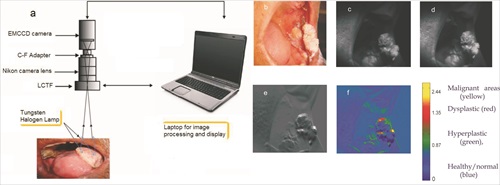Members Login

Channels
Special Offers & Promotions
Andor Luca-R camera sheds light on Oral Cancer
Diffuse Reflectance Imaging validated for early non-invasive detection of malignant and pre-malignant tumours
A team of Indian cancer researchers led by Dr Narayanan Subhash has developed a simple, non-invasive spectral imaging system that holds out the possibility of rapid, inexpensive mass screening for oral cancers in dental and clinical settings. Even in the hands of non-clinical staff, it is capable of real-time discrimination of healthy oral tissue from pre-malignant and malignant tissues with accuracy comparable to the gold standard histopathology of a biopsy sample.
The core of their novel Diffuse Reflectance Imaging System (DRIS) is an Andor Luca-R EMCCD camera, which captures monochrome images of the patient's mouth at 545 and 575 nm. Andor's SOLIS software computes a ratio image
(R545/R575) of the area under investigation and generates a Pseudo Colour Map (PCM) where blue designates healthy tissue, red denotes dysplastic/pre-malignant tissue and yellow identifies malignant tissue. This allows rapid visual differentiation of oral lesions and identification of regions with pre-malignant characteristics.
"Since mortality from oral cancer is particularly high, early detection, diagnosis and treatment is vital in increasing the survival rate of those with the disease," says Dr Subhash. "Our imaging method has the great advantage of non-invasively scanning entire lesions and their surrounding areas and automatically categorising these oral lesions into normal/clinically healthy, pre-malignant, and malignant tissue in real-time."
"It also delineates the boundaries of neoplastic changes and locates sites with the most malignant potential for biopsy, thereby avoiding unnecessary repeated biopsies and delay in diagnosis. What's more, imaging the entire region may also help the surgeons to identify the margins of the lesion that cannot be easily visualized by the naked eye during surgical interventions."
"The Luca-R EMCCD camera is well-equipped to handle this demanding role," says Orla Hanrahan of Andor. "Cost-effective yet powerful, it is built around a monochrome, megapixel frame transfer EMCCD sensor to deliver single photon detection sensitivity and unrestrained QE (65% max) in a TE cooled, USB 2.0 camera platform. Andor's exclusive RealGain EM gain control offers enhanced user-friendliness and quantitative reproducibility, setting a new precedent in day-to-day EMCCD use."
About Oral Cancer
Oral cancer is a significant and growing killer worldwide. Incidence rates for men and women in the UK have risen by almost 80% since the mid-1970s, with major risk factors cited as heavy alcohol consumption, smoking, infection with human papilloma virus (HPV) and the chewing of betel quid.
This last factor is much more significant in the Indian sub-continent and South-East Asia and the work of the team in India has proven Diffuse Reflectance Imaging has the potential to be a valuable, non-invasive tool in the continuing fight against cancer. Furthermore, the multi-spectral DR imaging technique presented in their paper has the potential to be used as an adjunct to colposcopy in the screening of cervical pre-cancers and in the identification the most malignant site for biopsy.
more about Luca-R EMCCD camera
more news from Andor Technoogy
Media Partners



